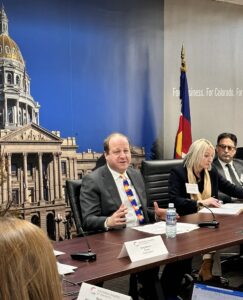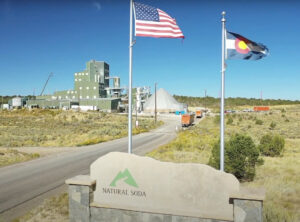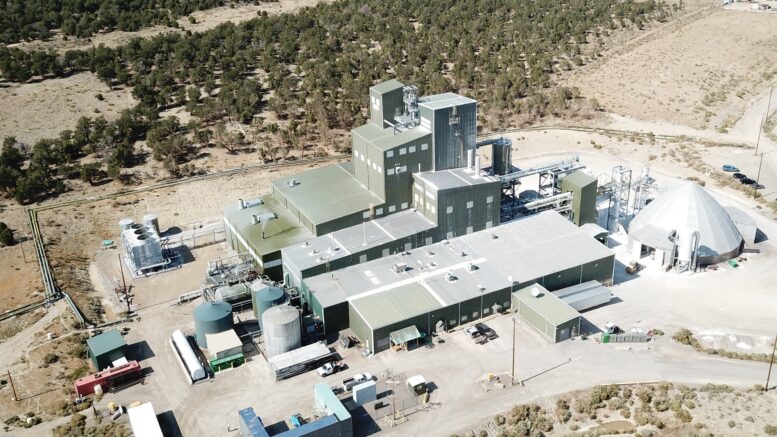Colorado will take a major step in the next week toward cutting emissions from the state’s largest manufacturing facilities, but business leaders warn that the current proposal could push production activity out of state without reducing global emissions.
A coalition of businesses led by the Colorado Chamber of Commerce is not asking the Colorado Air Quality Control Commission to reject the proposed Greenhouse Gas and Energy Management for Manufacturing Phase 2 (GEMM 2) regulations during a rulemaking hearing scheduled from Wednesday through Friday. However, it is presenting an alternate proposal in which the state would give affected businesses — which range from petroleum refineries to breweries to a mozzarella cheese maker — more ways to comply, including a mitigation fund into which they can pay.
On the other side of the coin, climate-advocacy groups like the Environmental Defense Fund argue that the envisioned rules are too lax and that proposed compliance pathways, including a credit-trading system, will leave the state far short of reaching its emissions-reduction goals. Also, they argue, provisions in the regulations offered by the Colorado Air Pollution Control Division do not do enough to quickly remove pollutants from disproportionately impacted communities in lower-income areas, which goes against the purpose of the 2021 Environmental Justice Act in which the mandate for GEMM 2 was established.
What’s at stake for manufacturers
John Jacus — a partner with Davis Graham & Stubbs who represents four of the affected companies and serves on the Colorado Chamber board — emphasized that manufacturers want to reduce emissions and, in some cases, have spent millions of dollars upgrading their factories to do so in recent years.
The Environmental Justice Act required emissions reductions from the sector of 20% by 2030 as compared to 2015 levels, and the APCD has said in filings that emissions from the targeted facilities already are down 12% versus eight years ago. The proposal includes 2024 greenhouse gas emissions limits that require reductions of 13% from 2015 levels to ensure accountability and measurable progress.
But because emissions aren’t confined within state borders and most manufacturers can move production to less regulated states, Colorado must be careful not to make it so hard to comply with rules that producers won’t just relocate to other places, Jacus said. If that happens, particularly with consumer-focused products like gasoline or beer, those companies then will ship their goods back into Colorado — and boost emissions from the transportation sector.

John Jacus is a partner at Davis Graham & Stubbs.
“Unless it’s adopted in a significantly revised form as proposed by the chamber and many of its members, it could have significantly negative consequences and little climate benefit,” Jacus said of GEMM. “They’re just not stepping back and seeing the bigger picture in my view.”
Who is affected
Over the past two years, Colorado has made many attempts to reduce emissions from various sectors — tying highway-expansion approval to reduced emissions, requiring building owners to cut energy intensity and launching new regulations on oil and gas, among other things. The manufacturing sector is a significant contributor of emissions in Colorado, leading Colorado to impose GEMM 1 rules in 2021 on a quartet of steel mills and cement plants and to develop the GEMM 2 regulations that, when combined with GEMM 1, will regulate manufacturers responsible for 75% of their sector’s emissions.
The 18 newly affected facilities each emit more than 25,000 metric tons of carbon-dioxide equivalents per year, with 14 of them sitting within a mile of disproportionately impacted communities exposed to high emissions levels for many years. Those 14 are subject to stricter rules requiring more onsite upgrades to emission-generating equipment.
The 18 companies include high-profile businesses such as the Suncor Energy refinery in Commerce City, the Molson Coors brewery in Golden and the Greeley plants belonging to beef producer JBS Swift and Leprino Foods, the largest mozzarella cheese maker in the world. But they also include Colorado employers such as the Natural Soda baking-soda mine in Rio Blanco County, the Western Sugar Cooperative in Denver and two glass producers — Owens-Brockway Glass Container Inc. and Rocky Mountain Bottle Co.
Under the proposed regulations, the manufacturers must submit a GHG reduction plan by the end of September 2025 detailing how they’ll reduce emissions from 2015 levels, and the sector as a whole — rather than each individual facility — must be down 20% by 2030. Facilities that have made large capital investments since 2016 and not yet realized full production from those investments would be granted an adjustment in their baseline to ensure they can utilize investments.
How manufacturers will comply
Manufacturers would be required first to reduce onsite emissions through technically feasible cost-reduction measures like equipment upgrades, efficiency increases and installation of additional controls. The proposed rule defines what is cost-effective as an emissions-reduction measure equal to or below the social cost of greenhouse gases — about $89 per metric ton of carbon dioxide equivalent by 2030.
Facilities would get different goals based on the emissions reductions they have achieved since 2015 (with those having made greater progress already to get less-restrictive regulations going forward) and based on the percentage of sector emissions they contribute, with bigger emitters getting tougher requirements. Those unable to achieve compliance via onsite upgrades could purchase credits given to other manufacturers who exceed their emissions-reduction goals in what is often referred to as a cap-and-trade system but what is more accurately described in this proposal as a greenhouse-gas “credit-trading system” only with other GEMM 1 and GEMM 2 facilities.
With less than two dozen Colorado companies potentially available to offer credits for purchase, Jacus said it’s more appropriate to call this a “cap-and-very-limited trade” system that could leave many more well-meaning manufacturers out of compliance. Thus, he and the Colorado Chamber submitted an alternate proposal to establish a GHG Reduction Fund into which GEMM 2 facilities would contribute based on their compliance shortfall — and which then would be used to fund emission-reduction projects statewide, focusing on emission sources within one mile of disproportionately impacted communities.
Outreach to Polis
A similar fund originally was part of the APCD proposal but was removed in the final version. Colorado Chamber leaders believe its reinsertion into the plan is so important that they penned a letter Thursday to Gov. Jared Polis asking that he support a final plan featuring this GHG reduction account in the final version of the rule.

Gov. Jared Polis speaks to a Colorado Chamber of Commerce board meeting earlier this year about his legislative agenda.
“The subject companies are left with the very real prospect that the production cuts may be their only means of complying with the rule,” the letter states. “If Colorado is to be economically competitive, forcing production cuts, directly or indirectly, as a means of compliance must be off the table.”
But just as business leaders are arguing that the plan offers too few options for regulated companies to comply, several environmental advocates argued in filings with the AQCC that the proposed options won’t do enough to achieve the state’s big-picture goals. And that, said groups ranging from EDF to GreenLatinos to a coalition of climate-focused family organizations, would leave already health-threatened areas with little relief and place the burden for decarbonizing back on other sectors.
Under provisions of a law passed earlier this year, the state must cut greenhouse gas emissions economywide 26% by 2025 and 50% by 2030. However, an EDF analysis found that Colorado now is on track to reduce emissions just 18% by 2025 and 35% by 2030 from 2005 levels.
Environmental pushback
An alternate proposal from EDF would not allow for such a mitigation fund and would clamp down on the proposed credit-trading system further.
Under that plan, the state would set annual caps on the emissions produced by GEMM 2 facilities, reducing those caps annually rather than setting goals just for 2024 and 2030. Manufacturers then would bid on credits equal to one metric ton of carbon dioxide equivalents and would have to submit the number of credits equal to their emissions every two to three years. So, rather than allowing players with significant emissions cuts to sell credits to companies with fewer cuts, this would incentivize compliance by lowering the amount that companies must pay based on their biennial or triennial emissions totals.
The current proposal, said EDF counsel Thomas Bloomfield in a prehearing statement, creates perverse incentives for companies to avoid onsite improvements by setting a cost-effectiveness standard so low that it makes the purchase of credits or payment into a fund fiscally preferable. That’s already played out with the GEMM 1 manufacturers after audits found that most of their proposed abatement projects were more expensive than a cost threshold and were eliminated as requirements, leaving the air in their surrounding communities no cleaner, he wrote.
“Given the urgency of the climate crisis and of advancing environmental justice in this state, EDF supported the passage of the Environmental Justice Act (HB21-1266), optimistic that the commission would fulfill this additional GHG abatement obligation and leverage the EJ Act to adopt a comprehensive set of regulations that meets the moment,” Bloomfield wrote. “The proposed rule falls well short of realizing the aspirations of the Environmental Justice Act.”
How it impacts one business

The entrance to the Natural Soda plant in Rio Blanco County
Watching all this closely is Kirk Daehling, the business director at Natural Soda who spent $7 million beginning in 2019 to install or upgrade boilers that were more energy-efficient and that had economizers to recover gases emitted from their stacks. Not only did the company — the only one in North America mining its sodium bicarbonate for baking soda from nahcolite, a more energy-efficient way of producing the substance — cut its emissions per product 23%, but it reduced overall emissions despite increasing production by 50,000 tons a year.
Now producing about 255,000 tons a year, the company is on pace to get to 300,000 tons and could, with further expansion, produce 500,000 tons annually — an increase that would require more hiring, which could be key as coal mines and coal-fired power plants around it shut down. But the proposed rules would curtail its production at 275,000 tons per year, an amount of growth so incremental that no new hiring would be needed and would a company that is trying to green itself and support its community forced to cede production to competitors with higher carbon footprints, Daehling said.
“That would cap our growth, cap local revenue, cap employment,” said Daehling, who admitted he just wants more flexibility from the rule to be able to grow while he is taking further steps to ramp down his emissions. “This is a market that is growing, and we would like to grow with demand … If we are capped, the market continues to grow and people buy from our competitors, which comes from out of state.”
